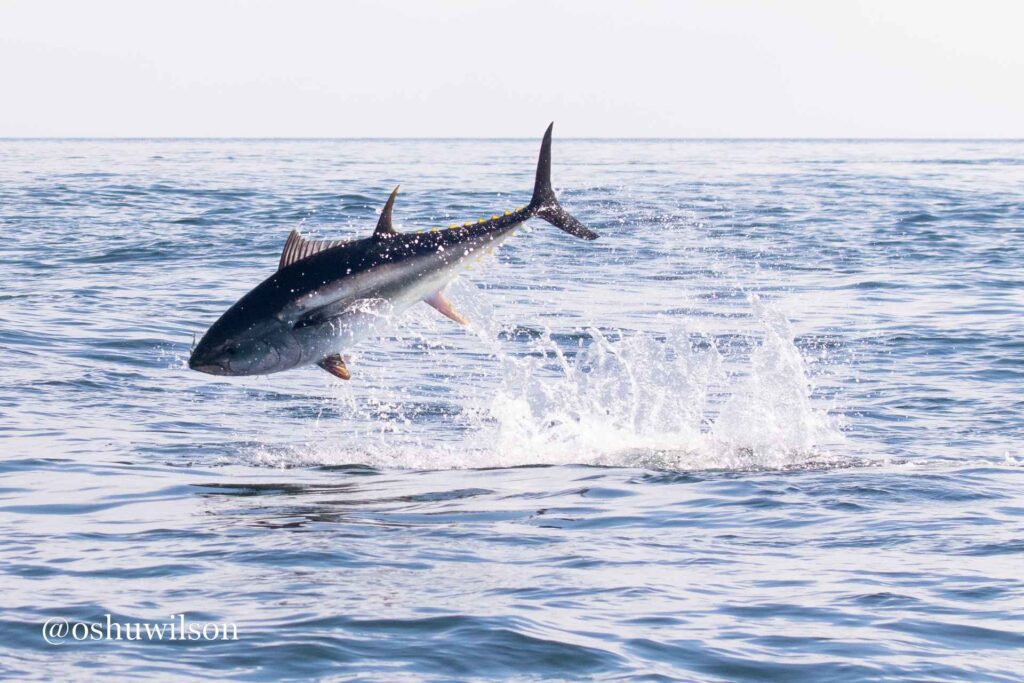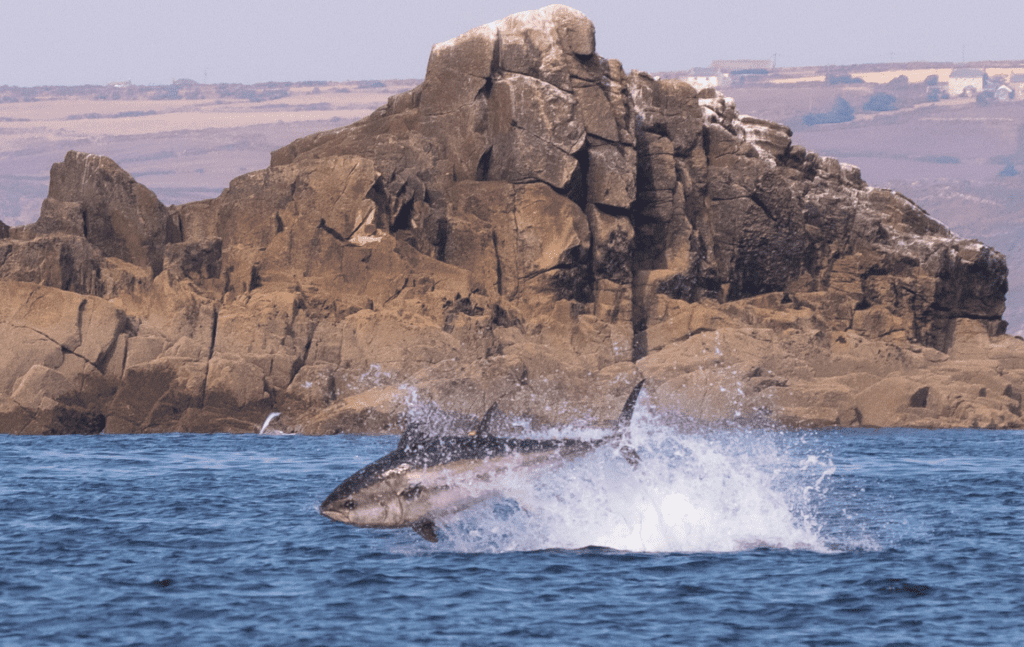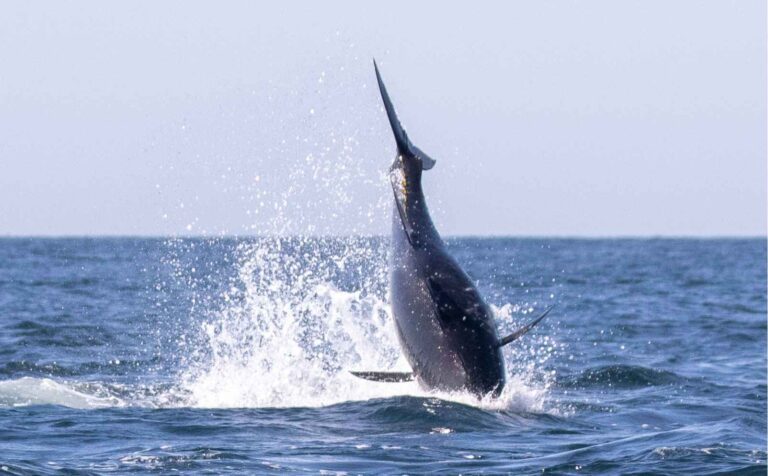Climate Change or Conservation Success Story?
Atlantic Bluefin Tuna are considered the largest tuna in the world, often reaching over six feet in length and weighing the same as a small car! We’re lucky enough to have frequent sightings of these ocean giants on our trips throughout the summer and autumn, but it hasn’t been an easy ride for these fierce fish. Despite their huge size, Atlantic Bluefin Tuna are vulnerable to overfishing and experienced significant population declines in the 1990s and early 2000s, causing them to appear absent from UK waters for many years. However, they’re back! It’s thought that this remarkable return is due to distribution shifts, which may be caused by changes in environmental conditions but could also be a result of concerted conservation efforts that have allowed populations to recover. Let’s dive right into the conservation story and the future implications for this iconic species.
Atlantic Bluefin Tuna is a highly valuable fish and Japan is a major importer of all bluefin species, for use in the sushi industry. It is estimated that 80% of the market in Japan is supplied by the many countries around the Mediterranean Sea. The number of countries involved in the fishing of this tuna stock is only increased due to Atlantic Bluefin Tuna being highly migratory. This means that conservation management of the species requires international cooperation, to allow the stock to be protected across its entire range. The International Commission for the Conservation of Atlantic Tunas (ICCAT) is responsible for the management and conservation of tuna in the Atlantic Ocean and its surrounding seas, with over 50 countries.

Photography by Josh Wilson @oshuwilson
ICCAT began setting fishing quotas for Atlantic Bluefin Tuna in 1998, however they went against scientific advice and set quotas too high, causing the population of tuna to remain overfished. Huge amounts of illegal fishing further contributed to declines in tuna stock. In 2007, ICCAT created a 15-year plan in an attempt to save the tuna population from collapse, further reducing quotas and increasing the minimum size of fish allowed to be caught. This was still not enough, leading to continued population declines and resulting in the International Union for the Conservation of Nature (IUCN) declaring Atlantic Bluefin Tuna “Endangered” in 2011. Soon after this, ICCAT began to base quotas on scientific advice and cracked down on illegal fishing by tracking tuna from catch to point of sale. These efforts have not been in vain, as tuna in the Eastern Atlantic are no longer classified as being overfished and the IUCN has moved Atlantic Bluefin Tuna from “Endangered” to “Least Concern”.
Local efforts are also not to go unnoticed. Historically, the UK has not been allowed to directly target Bluefin Tuna, but bycatch was often high especially in large fishing nets. Many Cornish fishers have changed the gear they use to target specific species and increase survival of any bycatch, so they can be safely released back into the ocean. Additionally, in 2021, the UK was granted its first quota for Bluefin Tuna. The majority of this quota is part of a catch-and-release project (CHART) in which selected skippers will be trained to take measurements and tag Bluefin Tuna, then release them unharmed. There has been a huge amount of interest in the project, with fishers keen to contribute to research of this amazing species. Findings from the project will help guide conservation efforts of Bluefin Tuna in UK waters but will also feed into wider management across the Atlantic.

Photography by Josh Wilson @oshuwilson
Finally, the public are getting behind Bluefin Tuna too! More and more interest is building around the apex predators, thanks to them being such an awesome sight to witness. Whether you are on the cliffs or on one of our boat trips, seeing such a huge fish leap out of the water will never fail to amaze you. The public truly recognise the importance of our ocean ecosystems and in a bid to protect it we have seen a rise in citizen scientists contributing to important research. Projects such as Thunnus UK have utilised the public’s enthusiasm to help record sightings of Bluefin Tuna around the Cornish coast and other UK waters, whilst also providing advice to fishers and running a satellite
tagging program. This collective effort is key to conserving our wildlife and sets a precedent for other projects around the world.
All this provides a lot of hope for Atlantic Bluefin Tuna, but other threats can’t be overlooked. We may be seeing these fish again in the UK due to an increase in sea temperatures causing bait fish numbers and distribution to change. Although this may not be a huge threat now, continuing climatic changes may put Bluefin Tuna at risk, especially if their spawning grounds are affected. Tuna return to the same spawning area every year and if the sea temperature becomes too high then their larvae may not survive. There is a lot of uncertainty surrounding these climatic factors, and the effect they have on Bluefin Tuna, which is why tagging projects such as CHART are so important to truly understand the increase in sightings.

Photography by Josh Wilson @oshuwilson
So, what about the future of the Bluefin Tuna in the UK? In 2023, the UK is trialling a commercial Bluefin Tuna fishery and a sports fishery is being considered off the coast of Cornwall. Although the UK stock looks good currently, fishing efforts will need to be monitored closely to ensure populations are not put under unnecessary stress. The IUCN also recommends that environmental conditions should be taken into account in new stock management plans, to further secure population stability. With collaboration between scientists, government and the public this can be a true conservation success story. Here at Coast Boat Trips, Bluefin Tuna are one of our favourite species to see and we hope that conservation will enable it to thrive in our waters in the future.
We hope to see you on board soon to hear more about Bluefin Tuna!
Written by Eve Tucker




